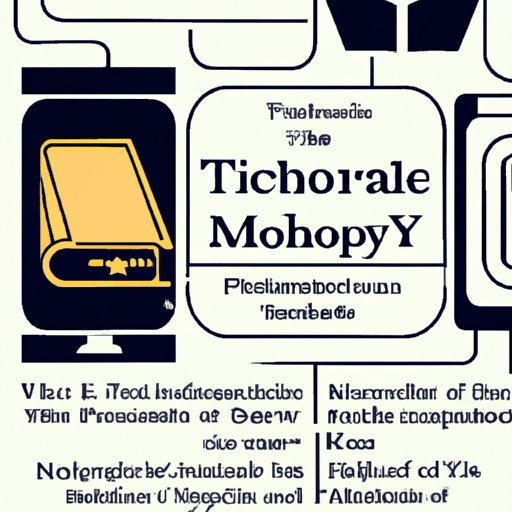Introduction
Modernism literature is a movement of the late 19th century and early 20th century that focused on individualism, fragmentation and experimentation. It was a reaction to the traditional literature of the time and sought to challenge the status quo. This article will explore the origins, influences, characteristics, and impact of modernism literature.
Origins, Influences and Characteristics of Modernism Literature
Modernism literature emerged in the late 19th century and early 20th century, primarily in Europe. According to literary scholar and professor Marjorie Perloff, “The term ‘modernism’ first emerged at the turn of the century to designate a set of aesthetic practices and attitudes that aimed to break with the past and invent new forms of expression” (Perloff, 2017).
Historical context played a major role in the emergence of modernism literature. The Industrial Revolution had resulted in rapid social and technological advances, which had caused upheaval in many aspects of life. These changes were reflected in the literature of the time, as writers sought to capture the chaos and complexity of the era.
Major influences on modernism literature included the rise of psychoanalysis, the cultural shifts of World War I, and the development of new technologies such as the telegraph, telephone, and radio. All of these factors contributed to a sense of instability and uncertainty, which was reflected in the literature of the time.
Key characteristics of modernism literature include an emphasis on individualism, fragmentation, experimentation, and ambiguity. Writers sought to capture the chaos and complexity of the era by creating works that challenged traditional forms and conventions. This often took the form of stream-of-consciousness writing, intentional ambiguity, and fragmentation.

Relationship Between Modernism and Postmodernism
Modernism and postmodernism are two movements that have had a significant impact on literature and other art forms. While both movements were reactions to traditional literature, there are some important differences between them.
One key difference is the focus on the individual. Modernism literature emphasized individualism, while postmodernism literature focused more on collective experience. Additionally, postmodernism literature was more interested in deconstructing existing structures and conventions, while modernism literature was more interested in creating new forms.
The emergence of postmodernism had a significant impact on modernism literature. Many modernist writers began to incorporate postmodern elements into their work, resulting in a hybrid style. This hybrid style has had a lasting impact on modernism literature and its subsequent iterations.

Impact of Modernism on Art and Culture
Modernism literature had a profound impact on art and culture. Its emphasis on experimentation and fragmentation led to innovations in visual arts, music, and film.
In the visual arts, modernism was characterized by abstract expressionism, cubism, and surrealism. These styles were a direct result of modernism literature’s emphasis on experimentation and breaking away from traditional forms.
In music, modernism literature had a major influence on jazz and classical music. Jazz musicians such as Duke Ellington and John Coltrane incorporated modernist techniques into their music, while classical composers such as Arnold Schoenberg and Igor Stravinsky experimented with new forms and structures.
Modernism literature also had a major impact on film. Directors such as Alfred Hitchcock and Orson Welles used modernist techniques to create groundbreaking films that challenged traditional conventions.

Role of Technology in Modernism Literature
Technology played an important role in modernism literature. The invention of new technologies such as the telegraph, telephone, and radio enabled writers to experiment with new mediums and reach a wider audience.
New technologies also allowed for the intersection of technology and literature. Writers began to explore the potential of new technologies to enhance their work, creating multimedia works that combined text, sound, and visuals.
Technology also enabled writers to experiment with new forms of distribution. Writers such as Virginia Woolf used new technologies to self-publish and distribute their work, allowing them to bypass traditional publishing channels.
Comparison of Modernism and Traditional Literature
Modernism literature was a reaction to traditional literature of the time. It focused on individualism, fragmentation, and experimentation, while traditional literature focused on conformity, structure, and order.
Modernism literature also challenged traditional themes and motifs. Instead of focusing on grand narratives, it focused on the individual and their experience of the world. It also explored themes such as alienation, identity, and despair, which were not commonly found in traditional literature.
Modernism literature also challenged traditional language and structure. Writers experimented with new forms of expression and used techniques such as stream of consciousness, intentional ambiguity, and fragmentation. This was in stark contrast to traditional literature, which was focused on linearity and clarity.
Experimental Techniques of Modernist Writers
Modernist writers used a variety of experimental techniques to capture the chaos and complexity of the era. These techniques included stream of consciousness, intentional ambiguity, and fragmentation.
Stream of consciousness was a technique used by writers such as James Joyce and Virginia Woolf to capture the inner thoughts and feelings of characters. It was a way of conveying the character’s internal experience without resorting to traditional narrative.
Intentional ambiguity was another technique used by modernist writers. It was a way of leaving the meaning of a text open to interpretation, allowing readers to make their own conclusions.
Fragmentation was a technique used by writers such as Ezra Pound and T.S. Eliot to create works that were non-linear and disjointed. This was a way of capturing the feeling of chaos and confusion that was prevalent during the period.
Conclusion
Modernism literature is a movement of the late 19th century and early 20th century that focused on individualism, fragmentation and experimentation. This article has explored the origins, influences, characteristics, and impact of modernism literature. It has also examined the relationship between modernism and postmodernism, the impact of modernism on art and culture, the role of technology in modernism literature, and the comparison of modernism and traditional literature. Finally, it has discussed the experimental techniques used by modernist writers.
Modernism literature has had a lasting impact on literature and other art forms. Its emphasis on experimentation, fragmentation, and ambiguity has resulted in works that challenge traditional forms and conventions. It has also paved the way for subsequent movements such as postmodernism, which continue to shape literature and other art forms today.
Modernism literature is a testament to the power of experimentation and innovation. Its legacy continues to inspire generations of writers, artists, and creators to push boundaries and create works that challenge traditional forms and conventions.
(Note: Is this article not meeting your expectations? Do you have knowledge or insights to share? Unlock new opportunities and expand your reach by joining our authors team. Click Registration to join us and share your expertise with our readers.)
